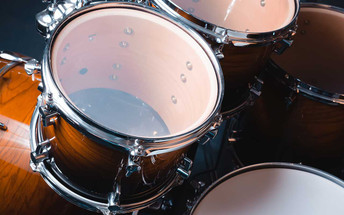DIY Drum Enclosure

DIY Drum Enclosure
Total Plastics receives a lot of requests from individuals building a custom drum set enclosure or drum shield. Typically, the enclosure is for a church’s worship team who is looking to soften the sound of the drummer. There are many things to consider if you’re looking to build your own drum enclosure.
Drum Shield Basics
If you’re researching the application, it’s typically called a drum shield or drum screen. At its most basic, the finished drum shield is comprised of 6-8 clear plastic panels with each panel measuring around 24 inches wide by 48-72 inches tall. The 1/8 to 1/4 inch-thick panels are connected by either a plastic living hinge or piano hinge. For that basic setup, someone constructing a drum shield can complete the project for under $500. In our most recent requests, panels are typically 24 inches wide, 72 inches tall and 1/4 inch thick.
Polycarbonate or Acrylic?
There are typically two choices for material: acrylic or polycarbonate. If you’re researching drum shields online, you’ll likely come across ClearSonic Manufacturing out of Ohio. They would be considered market leaders and primarily use acrylic. There are advantages to using acrylic. First, it’s often less expensive than polycarbonate. Second, it’s more scratch-resistant than polycarbonate. Third, aesthetically speaking, it has a better-finished look (higher gloss and better polish).
Many choose to use polycarbonate simply for its strength. Whereas acrylic can be brittle and easy to break, polycarbonate is virtually unbreakable. If the drum shield gets bumped into and falls, acrylic would likely break. Polycarbonate would not. However, as stated above, polycarbonate is softer and tends to scratch easier. If you’re bending the sheet at any sort of radius, either material could work, but polycarbonate will be more forgiving and give you a greater degree against failure (i.e. the sheet breaking).
Colored Acrylic Sheet and Other Options
One of the benefits of using acrylic is that it’s commonly available in a wide variety of translucent colors and tints. Depending on the overall design of your drum shield, you can incorporate different colors to match stage design and branding. Colored translucent sheets would still allow a high level of light transmission and wouldn’t significantly prohibit the ability of the drummer to view the rest of the band, nor the audience’s ability to view the drummer.
If glare from stage lights becomes an issue, non-glare acrylic sheets are also available. For both polycarbonate and acrylic, hard-coated material (one-sided or two) is another option and will help prevent scratching and extend the life of the sheet. The hard coating could affect the sheets formability if you’re looking to bend it. Also, the hard coating will add cost.
Use a local Plastic Distributor
As you can imagine, shipping an 80×120-inch, quarter-inch thick, acrylic sheet can be cost-prohibitive. Shipping costs can be as much as the sheet itself, in some cases. In just about every major city there’s a plastic distributor, like Total Plastics, that specializes in plastic sheet, rod and tube. Acrylic and polycarbonate are commonly stocked materials. If you’re looking to keep costs down, contact a plastic local distributor. In many cases, customers can pick up the material from the warehouse and avoid freight costs.
The other benefit of using a distributor is that many can provide cut-to-size services. Handling and cutting a 48×96-inch sheet can be difficult, and even dangerous. Plastic distributors can cut, rout and pre-drill the sheet for you, providing you with a ready-to-install panel. You may also inquire about edge finishing to eliminate any sharp edges and corners. It isn’t an uncommon scenario that a 48×96-inch sheet of acrylic gets mishandled by the customer and breaks while they try to cut it.
Connecting the Panels
There are a few common options for connecting the panels and completing the drum shield. At the high-end of the spectrum, some build a metal frame to house the panels. This is a great option for more permanent drum enclosures. At the other end of the spectrum is the plastic living hinge. This is also commonly offered by local distributors. A living hinge is a simple, affordable solution for connecting the plastic panels while still allowing flexibility in the final setup. A long piano hinge is commonly used as well. For a group that performs shows at multiple venues, a piano hinge would allow you to collapse the drum shield down flat and carry it away easily.
Additional Sound Deadening
Additional materials are available through your plastic distributor for additional sound deadening. Total Plastics, for instance, carries PET felt board, a light-weight material that would be ideal as a ceiling, of sorts, over the top of the drum shield. Plywood is commonly used in this application, but there are concerns about its weight. The PET felt board could installed by one person and, should it ever fall, would case less damage. This material could also be used as a rear door or back to the drum enclosure, allowing the drummer to easily move it to enter or exit.
Avoid uses Household Window Cleaners
Plastic and ammonia don’t get along. That is why common household glass cleaners should not be used on acrylic or polycarbonate. Over time, the ammonia will damage the plastic sheet, causing crazing or small cracks that will eventually distort the transparency of the material. There are specially developed plastic polishes and cleaners, like Brillianize. Using those specialty cleaners along with a microfiber towel is recommended for regular cleaning and maintenance. A rough, dry paper towel could scratch the surface of polycarbonate.
Avoid using household glass cleaners on any plastic. This could include glasses, DVDs, CDs, computer screens, picture frames, flat-screen TVs, faceshields, visors, motorcycle shields, office partitions, ATV windshields and much more. Again, ammonia-based cleaning products will damage the plastic.

